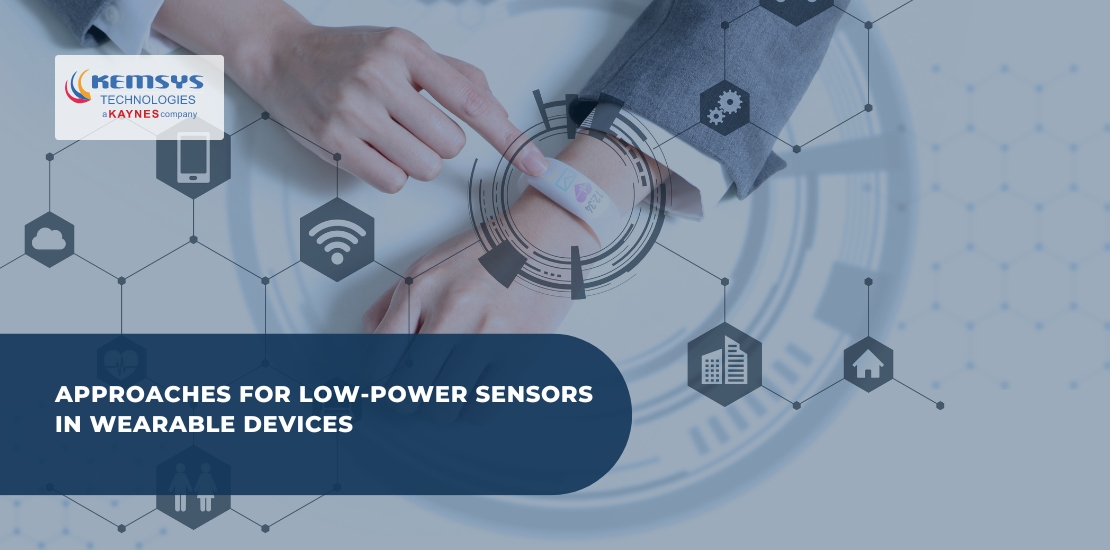- July 19, 2023
- Posted by: Swapnil Ghaisas
- Category: Device Engineering

Wearable devices, equipped with low-power sensors, have experienced a remarkable surge in popularity over the past decade, revolutionizing the way we interact with technology and augmenting various aspects of our daily lives.
These smart devices, which are seamlessly integrated into our clothing or worn as accessories, have garnered widespread attention due to their versatility, convenience, and ability to enhance our overall well-being.
The driving force behind this popularity lies in their diverse functionalities and the innovative use of low-power sensors that make them highly efficient and user-friendly.
Recent advances in wearable sensing have led to smaller, more energy-efficient sensors that can seamlessly integrate into various wearable devices.
These advancements enable real-time monitoring of health parameters, activity levels, and environmental factors, revolutionizing personalized healthcare and lifestyle management.
In this blog we will delve deeper into the world of low power sensors in wearable devices.
- The Growing Popularity of Wearable Devices
- Low-Power Sensors and their Role in Wearable Technology
- Advantages of Low-Power Sensors in Wearable Devices
- How Low-Power Sensors Contribute to Prolonged Battery Life
- Importance of Compact and Efficient Sensor Designs in Wearable Devices
- Wrapping Up
- FAQs (Frequently Asked Questions)
- Read More
The Growing Popularity of Wearable Devices
Health and Fitness Tracking
One of the primary reasons for the growing popularity of wearable devices is their ability to monitor and track health and fitness metrics.
These devices come equipped with a range of sensors, including heart rate monitors, accelerometers, and GPS trackers, allowing users to monitor their physical activities, sleep patterns, and overall health in real-time.
This data-driven approach to fitness has empowered individuals to take charge of their well-being and make informed lifestyle choices.
Seamless Connectivity
Wearable devices act as natural extensions of our smartphones and other devices, creating a seamless and integrated user experience.
Through wireless connectivity, wearables can receive notifications, calls, messages, and other alerts, reducing the need for users to constantly check their phones.
This has not only improved efficiency but also minimized distractions in daily life.
Fashion and Personalization
The design and aesthetics of wearable devices have come a long way since their inception.
Today, wearables cater to diverse styles and preferences, appealing to a broad range of users.
The ability to customize watch faces, straps, and overall appearance allows users to express their personality while embracing cutting-edge technology.
Enhanced Productivity
Wearable devices have found applications beyond the realm of fitness and fashion.
They have also become valuable tools in improving productivity and efficiency.
Smartwatches, for example, can display calendars, reminders, and to-do lists, enabling users to stay organized and focused throughout the day.
Low-Power Sensors and their Role in Wearable Technology
Low-power sensors refer to specialized electronic components designed to operate efficiently while consuming minimal energy. These sensors are crucial components in wearable technology, where power efficiency is of utmost importance due to the device’s small form factor and the need for extended battery life.
Low-power sensors are integrated into wearable devices to detect and measure various environmental, physiological, and user-interaction data. They play a pivotal role in enabling wearables to function effectively and provide valuable insights to users for health monitoring, activity tracking, and other functionalities.

Advantages of Low-Power Sensors in Wearable Devices
Wearable devices have emerged as a revolutionary technology, integrating seamlessly into our daily lives and offering an array of benefits ranging from health tracking to improved communication. These smart gadgets have become increasingly popular due to their convenience and versatility.
A critical aspect that enables wearables to function efficiently and effectively is the use of low-power sensors. These tiny yet powerful components play a pivotal role in enhancing the overall functionality of wearables, making them more user-friendly and practical.
Extended Battery Life
One of the most significant advantages of using lower power sensors in wearable devices is the substantial increase in battery life.
These sensors are designed to operate efficiently and consume minimal power, allowing wearables to function for extended periods without the need for frequent recharging.
Users can rely on their devices for continuous health tracking, activity monitoring, and other functionalities without worrying about the battery running out quickly.
Improved User Experience
Lower power sensors contribute to a seamless and uninterrupted user experience.
By reducing energy consumption, wearables can remain responsive and operational for more extended periods.
Users can interact with their devices without experiencing delays or interruptions, enhancing overall satisfaction and usability.
Real-Time Data Collection
Lower power sensors enable wearables to collect and process data in real-time.
Whether it’s heart rate monitoring, sleep tracking, or step counting, these sensors ensure that users receive immediate and up-to-date information, enabling them to make timely and informed decisions about their health and activities.
Comfortable and Lightweight Design
Wearables are meant to be worn comfortably throughout the day.
Lower power sensors are typically smaller and generate less heat, allowing for a more compact and lightweight design.
The reduced size and thermal output contribute to wearables that are comfortable to wear for extended periods without causing discomfort to the user.
Energy-Efficient Sensing
Lower power sensors are engineered to optimize energy usage.
They can employ techniques like duty cycling (activating sensors intermittently) and adaptive sampling (adjusting data collection frequency based on user activity) to reduce power consumption while still providing accurate and relevant data.
This energy-efficient sensing ensures that wearables can continuously monitor various metrics without draining the battery quickly.
Sustainable Technology
With the increasing demand for wearable devices, energy efficiency becomes crucial in promoting sustainable technology.
Lower power sensors help reduce the overall environmental impact of wearable devices by conserving energy and extending the device’s lifespan.
This approach contributes to a more eco-friendly and responsible use of technology.
Innovative Functionality
The integration of lower power sensors has opened up new possibilities for wearable device functionality.
These sensors enable wearables to introduce innovative features and capabilities without compromising on energy efficiency.
From advanced health monitoring to environmental sensing, lower power sensors have paved the way for valuable and diverse functionalities in wearables.
Minimized Data Transfers
Lower power sensors often perform data processing on the device itself, reducing the need to transmit large amounts of raw data to external sources.
This not only saves energy but also minimizes the burden on network resources, leading to faster and more efficient data transfer and analysis.
How Low-Power Sensors Contribute to Prolonged Battery Life
Low-power sensors play a crucial role in contributing to prolonged battery life in wearable devices through various mechanisms:
Optimized Power Consumption
Low-power sensors are specifically designed to operate efficiently while consuming minimal energy.
They employ advanced power management techniques, such as duty cycling and power gating, which allow them to activate and deactivate at appropriate intervals.
By reducing the time they remain active, these sensors conserve power and extend the overall battery life of the wearable device.
Efficient Data Processing
Many low-power sensors are equipped with on-device data processing capabilities.
This means that they can analyze and process data locally, without the need to constantly transmit raw data to external devices or cloud servers.
By performing data processing on the device itself, the need for energy-intensive data transfers is minimized, leading to significant power savings.
Adaptive Sampling Rates
Low-power sensors can dynamically adjust their data collection frequency based on user activity or environmental conditions.
For instance, in a fitness tracker, the sensor might increase its sampling rate during intense workouts and reduce it during periods of rest.
This adaptive sampling ensures that the device only gathers data when necessary, conserving energy and maximizing battery efficiency.
Low Standby Power Consumption
Low-power sensors are designed to consume minimal power when in standby or sleep mode. These modes are activated when the sensor is not actively collecting data. During these periods, power consumption is kept to a minimum, ensuring that the wearable device remains operational for longer durations without drawing heavily from the battery.
Energy-Efficient Hardware
Advancements in sensor technology have led to the development of energy-efficient hardware.
Manufacturers use specialized materials and optimized designs that reduce power consumption without compromising sensor performance.
The integration of these efficient components ensures that wearable devices can perform various tasks while consuming minimal energy.
Sensor Fusion Techniques
Some wearable devices employ sensor fusion, combining data from multiple low-power sensors to gain more comprehensive insights.
By using complementary data from different sensors, the device can minimize redundant measurements and optimize power usage while maintaining accurate data representation.
Power Optimization Algorithms
Wearable devices often incorporate power optimization algorithms that intelligently manage sensor usage based on user behavior and needs.
These algorithms can determine the appropriate times to activate specific sensors, ensuring that energy is conserved while still providing timely and relevant data.
Importance of Compact and Efficient Sensor Designs in Wearable Devices
The success of wearable devices hinges on the optimal design and integration of sensors, ensuring they are compact, efficient, and seamlessly incorporated into the device.
Achieving these objectives holds paramount importance for several reasons:
- Enhanced Wearability: Compact sensor designs are essential to ensure wearables are lightweight and comfortable to wear for extended periods. Bulky or cumbersome sensors can lead to discomfort and hinder user adoption. Efficiently designed sensors also contribute to the overall aesthetics of the wearable, making them more visually appealing and appealing to a broader audience.
- Accuracy and Reliability: Compact and well-designed sensors are more likely to maintain accurate and reliable performance. By minimizing signal interference and noise, these sensors can deliver precise data, leading to more dependable health and activity tracking results. Users rely on the accuracy of the data collected by wearables, making sensor design a critical factor in ensuring data fidelity.
- Seamless Data Integration: Seamless integration of sensors into wearable devices is essential for a cohesive user experience. When sensors are thoughtfully integrated into the device’s design, they become less obtrusive, reducing the risk of accidental damage or detachment. This seamless integration also facilitates smoother data transfer and processing, enabling real-time insights and enhancing the overall usability of the wearable.
- Optimal Functionality: Efficient sensor designs contribute to the overall functionality of wearables. By providing accurate data in a timely manner, these sensors enable wearables to deliver meaningful insights to users. Whether it’s heart rate monitoring, sleep tracking, or activity analysis, well-integrated sensors enhance the device’s capabilities and make wearables more valuable tools for users.
- Space Efficiency: The space within wearable devices is limited, necessitating compact sensor designs. By minimizing the sensor’s physical footprint, more room is available for other essential components, such as the battery, display, and processor. Efficient space utilization allows wearables to pack more functionality into a smaller form factor, further improving user experience and wearability.
- Market Competitiveness: In the highly competitive wearable technology market, well-designed and integrated sensors can be a differentiating factor for manufacturers. Devices that offer a sleek and user-friendly design, while delivering accurate and efficient data, are more likely to stand out and attract a larger customer base.
Wrapping Up
The growing popularity of wearable devices has revolutionized the way we interact with technology and integrate it into our daily lives. A significant contributing factor to this popularity is the remarkable advancement and integration of low-power sensors in wearable technology.
Low-power sensors have emerged as key components in wearable devices, enabling these smart gadgets to function efficiently and effectively. Their ability to consume minimal energy while delivering accurate and real-time data has transformed wearables into valuable tools for health monitoring, activity tracking, and various other functionalities.
These sensors contribute to prolonged battery life, a critical aspect for continuous usage and seamless user experiences. By optimizing power consumption, wearables can operate for extended periods without frequent recharging, empowering users to rely on their devices throughout the day.
Moreover, low-power sensors ensure a comfortable and lightweight design, making wearables more wearable for extended periods without compromising on performance. The reduction in sensor size and thermal output allows for sleek and visually appealing wearables, catering to diverse user preferences and styles.
The importance of compact and efficient sensor designs in wearable devices cannot be overstated. A well-designed sensor optimizes space utilization within the wearable, leaving room for other essential components and further improving user experience and wearability.
FAQs (Frequently Asked Questions)
1. What are low-power sensors in wearable devices?
Low-power sensors in wearable devices refer to specialized electronic components designed to operate efficiently while consuming minimal energy. These sensors play a crucial role in enhancing the overall functionality of wearables by optimizing power consumption and ensuring prolonged battery life.
2. How do low-power sensors contribute to prolonged battery life in wearables?
Low-power sensors consume minimal energy during operation, reducing the overall power drain on the wearable device. By efficiently managing power usage and employing techniques like duty cycling and adaptive sampling, these sensors enable wearables to function for extended periods without frequent recharging.
3. Can low-power sensors be used for health and fitness tracking in wearables? Yes, low-power sensors are widely used for health and fitness tracking in wearables. They can monitor heart rate, track physical activities, measure sleep patterns, and provide valuable health insights to users in real-time, contributing to improved overall well-being.
4. Do low-power sensors impact the accuracy of data collected by wearables?
No, low-power sensors are designed to maintain accuracy and reliability in data collection. Their optimized power consumption does not compromise the quality of data insights, ensuring that wearables provide precise information to users.
5. What advancements can we expect in low-power sensor technology for wearables? As technology continues to evolve, we can expect continuous advancements in low-power sensor technology. These may include further reductions in energy consumption, enhanced sensor capabilities, and integration with other innovative features in wearable devices.
6. How do low-power sensors benefit wearable device manufacturers? For wearable device manufacturers, low-power sensors offer a competitive edge. By providing energy-efficient wearables with extended battery life and improved user experiences, manufacturers can attract more customers and stay ahead in the rapidly evolving wearable technology market.
Read More
- Artificial Intelligence Use Cases in Industrial Manufacturing
- Building a Scalable IoT Architecture for Industrial Asset Management
- Prerequisites for Successful Implementation of IoT-based Industrial Asset Management
- The Impact of Predictive Maintenance on Asset Lifespan
- Navigating Challenges: Embracing Smart Industrial Asset Management

